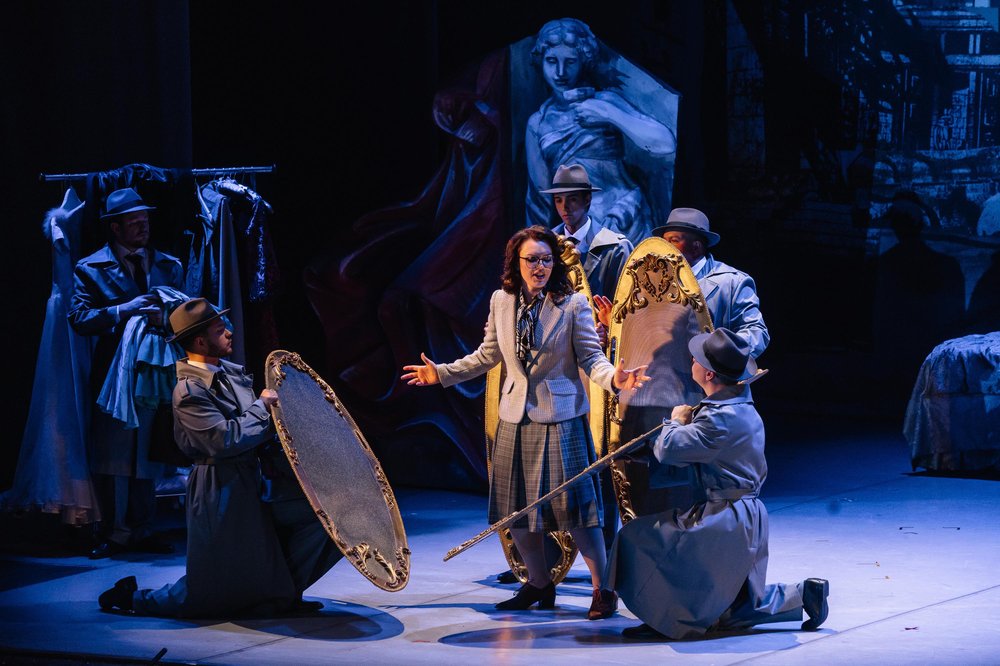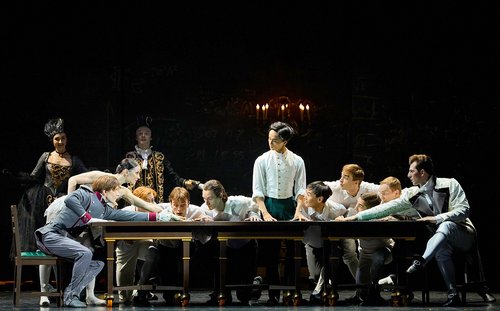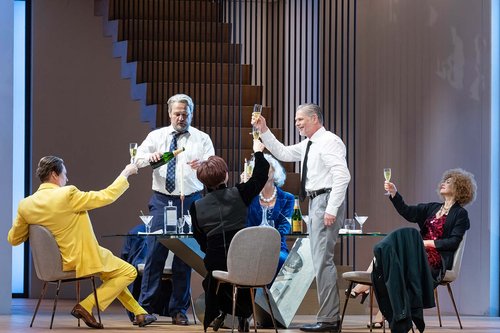Koshlyakov meets Weinberg in a genre-defying opera about the three Muskateers in Nizhny Novgorod

Mieczyslaw Weinberg. The Love of D’Artagnan. Courtesy of Nizhny Novgorod State Academic Theatre for Opera and Ballet named after A.S.Pushkin
Nizhny Novgorod Opera and Ballet Theatre is hosting the premiere of Mieczyslaw Weinberg’s opera ‘The Love of D’Artagnan’ with sets designed by Paris-based Russian contemporary artist Valery Koshlyakov.
With the arrival of Alexei Trifonov (b. 1976), new artistic director at the Nizhny Novgorod theatre of opera and ballet, there has been a gear shift in the institution marking a change from a period of relative creative atrophy to a new era characterised by the experimental creative paradigm of the 21st century. Its orchestra La Voce Strumentale under creator and chief conductor Dmitry Sinkovsky is playing an ever expanding repertoire with new concert and festival programmes and there are tours to Moscow as well as the appearance of a second venue in the Warehouses at Strelka designed by Russian starchitect Sergei Tchoban. There is even talk of the construction of a new building as the current space is not well suited to the multiple needs of contemporary music and theatre.
With not one but two works by Mieczyslaw Weinberg (1919–1996) in the same season – not to mention his ballet ‘Golden Key’ which premiered at Nizhny Novgorod’s theatre last Winter – it is a clear sign of the management’s progressive thinking. A decade ago there was a powerful renaissance of Weinberg’s music – a contemporary of Dmitry Shostakovich (1906–1975) – when not only several of his unpublished musical studies were printed, but his work finally began to be played in opera houses. ‘The Passenger Girl’, an opera based on a story by Zofia Posmysh, a survivor of Auschwitz, was staged in Ekaterinburg and at the Novaya Opera in Moscow; ‘The Idiot’ based on Dostoevsky’s novel was staged at the Bolshoi and Mariinsky. And there were several seasons where chamber, film and symphonic music by Weinberg occupied a significant part of concert programmes.
Weinberg was a Polish Jew who in the 1930s fled Nazi persecution and the only one in his family to somehow miraculously make it to the USSR, where he was granted asylum, a home and the opportunity to work. Shostakovich had a deep appreciation for his music and more than once wrote prefaces to Weinberg’s scores – including for ‘The Love of D’Artagnan’. His work was rediscovered by audiences in Western Europe even before it was properly known in Russia: the world premiere of ‘The Passenger Girl’ took place at the famous Bregenz Festival on Lake Constance in Austria, directed by Teodor Currentzis (b. 1972) – with whom Alexei Trifonov was working closely at the time. Trifonov recalls it was then that he saw the genius in Weinberg’s music and believed at the time that it should be included in standard opera repertoire. Now as artistic director at Nizhny Novgorod he has been able to fulfil this conviction.
In the past, ‘The Love of D’Artagnan’ has belonged to various musical genres. In the Soviet times it was staged as an operetta in the closed city of Sverdlovsk-44, (today Novouralsk), a kind of fantasy piece in Kuibyshev (today Samara), and finally as an opera. It seemed to become a kind of transitional, quasi experimental genre, which gave birth to the 21st century Russian musical. Some musicologists also find echoes of French lyric opera in it – like Bizet’s Carmen – but always strictly within the confines of musical-theatre with spoken dialogue and nothing more. This ambiguity in terms of its genre has given directors today free reign to unleash their own vision. Trifonov together with conductor Ivan Velikanov (b. 1986) have embellished the score with six ballet scenes which they took from Weinberg’s archive. In the dramaturgy of this production these fulfil either the function of dances as King Louis is a lover of ballet or alternatively can be seen as lyrical digressions.
This is not the only artistic liberty in this new production, as the composer and the libretto, based on a play by Eleonora Galperina (known by her pseudonym Nora Gal) diverge fundamentally from the original source material: all the women in the play remain alive at the end and rejoice at Queen Anne's triumphant performance in the Merlaison ballet. Igor Ushakov, the director is afforded huge slice of freedom, and he manages to create in Nizhny Novgorod the work as essentially a game of theatre. Ushakov transports his characters back to the 1970s when Dumas’s famous novel ‘The Three Musketeers’ was at the height of its popularity in the USSR, and became a nationwide success after the release of the film with music by Maxim Dunayevsky (b. 1945). The film ironically had a negative effect on Weinberg's opera as after the staging of only three productions the score was shelved.
In Ushakov’s production we see an amateur theatre troupe in a Soviet House of Culture who are allocating roles in The Three Musketeers. Young actors are scrutinised by people in grey cloaks who go on to play guards of the Cardinal. On a wooden horse, D’Artagnan and his servant Planchet suddenly appear on stage and the performance begins.
The set design for the production was made by contemporary Russian artist Valery Koshlyakov (b. 1962) who today has his studio in France. He started his career as a stage designer for the Musical Comedy Theatre in Rostov-on-Don in the south of Russia, and this is an unexpected comeback to musical theatre many years later. His scenography reflects the notion of how France, and French culture – or more broadly, Western European culture – sprouted up in the 1970s in Soviet Russia. On stage there are antique sculptures, the Pantheon cupola, wrought iron arches from park fences, architectural elements from constructivist buildings, floor lamps with fabric lampshades once a staple in Soviet era apartments, and elaborate chandeliers fit for a palace. Koshlyakov brings his idiosyncratic style to the set of The Love of D’Artagnan, where he combinescollage and paintings in which his images seem blurred as if in a haze. The interiors in the House of Culture are unusual examples of Soviet architecture, with rectangular columns cutting through a light and airy space. A ‘mosaic’ with a unbiquitous ballerina and cosmonaut is evokes Marc Chagall’s painted ceiling in the Grand Opera House in Paris.
As a kind of zakuski accompanying the premiere, the Nizhny Novgorod Arsenal centre for contemporary art has put on an exhibition called ‘Premonition of Opera’, with collages by Koshlyakov and in a small room there are recordings of the rehearsals played on a screen as well as projections of Koshlyakov's works inviting you to imagine them in unison with the music and have a sense of the production before you see it.
The Love of D’Artagnan
Nizhny Novgorod State Academic Theatre for Opera and Ballet named after A.S.Pushkin
Nizhny Novgorod, Russia

















